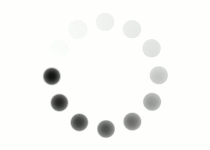It turns out that translations are not the only way to create a frieze pattern. Using other transformations, or a combination of transformations, also creates beautiful and intricate patterns. The following are a list of possible transformations that can be used to created a frieze pattern.
| Rotation | A 180° rotation can be used to create a frieze pattern. This transformation is denoted with an R. |
| Horizontal Reflection | A reflection in a horizontal line can be used to create a frieze pattern. This transformation is denoted with an H. |
| Vertical Reflection | A reflection in a vertical line can be used to create a frieze pattern. This transformation is denoted with a V. |
| Horizontal Glide Reflection | This translation combined with a reflection can be used to create a frieze pattern. This combination is denoted with a G. |
You can also combine these transformations to produce even more complex frieze patterns. Look at the following frieze pattern. Identify which transformations were used to create the pattern then click on the Answer Button to check your answer.

There are two ways you can create this frieze pattern.
1. First, it can be created by a horizontal translation. Take the following two patterns and translate them to the left and right. This can be denoted by the letter T.

2. The second way is a 180° rotation. Each small pattern, like the one below, is rotated 180°. This is denoted by the letter R.

